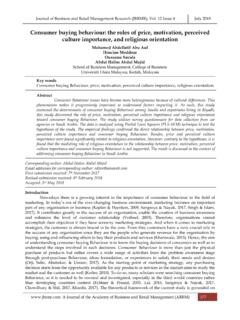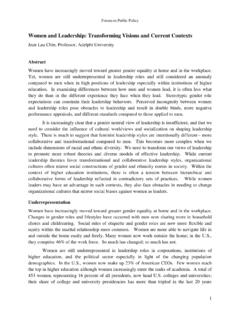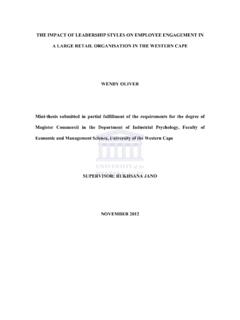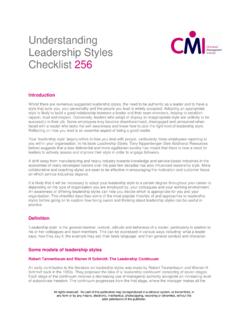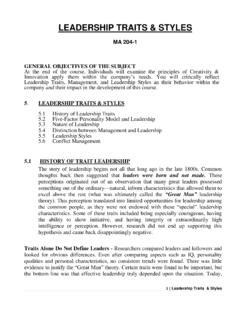Transcription of The relationships among leadership styles, communication ...
1 Journal of Business and Retail Management Research (JBRMR), Vol. 13 Issue 1 October 2018. The relationships among leadership styles , communication skills, and employee satisfaction: A study on equal employment opportunity in leadership Tri Wikaningrum Diponegoro University/ Universitas Islam Sultan Agung, Indonesia Udin Ahyar Yuniawan Diponegoro University, Indonesia Keywords leadership styles , communication skills, employee satisfaction, equal employment opportunity Abstract This study attempted to analyze the relationships among leadership styles , communication skills, and employee satisfaction.
2 This study also examined the potential of women in leadership to support the practice of equal employment opportunities from gender side in organization. Data were collected from 200 self- administered survey using questionnaires completed by employees at private Islamic universities in Semarang city, Indonesia. Regression analysis was used to test the hypotheses. The results showed that leadership styles and communication skills have a significant effect on employee satisfaction. However, based on employees' perceptions, this study revealed no significant difference between leadership styles and communication skills of male and female leaders.
3 Corresponding author: Udin Email address for corresponding author: First submission received: 7th November 2017. Revised submission received: 22nd January 2018. Accepted: 5th March 2018. Introduction There are many expert opinions on the importance of communication in leadership . According to Holladay and Coombs (1993), leadership is a behavior carried out by communication , in which communication clarifies perceptions of a leader's charisma. This is clarified by Hall & Lord's idea (1995), saying that the leader message conveys affective and cognitive strategies.
4 When the leader effectively communicates his/her vision, he/she is more likely to gain the employees' trust, which eventually affects communicating satisfaction between the leader and the followers (Madlock, 2008). Shaw (2005) stressed that in order to be perceived as competent communicators, leaders must share and respond to information on time, pay attention to others' points of view, communicate clearly and concisely to all levels of organization, and use all existing communication channels and various communicative resources such as language, gestures, and sounds.
5 communication skills also play an important role in influencing attitudes, such as employees' satisfaction. It is not only about satisfaction in terms of communication with leaders, but also satisfaction with their jobs. Effective leadership should not only be seen from how far the leaders' organizational unit succeeds in accomplishing the task of achieving their goals. Equally important is the process of leadership itself which then affects the employees'. perception on the leadership styles of their leaders. Employees perceive their leaders' behavior, mainly based on two categories ( , related to the purpose of the tasks and related to interpersonal relationships ).
6 Employees are most satisfied when they perceive their direct leaders run both behaviors (Madlock, 2008). Judged from the leadership styles , female leaders run their task-oriented leadership without ignoring good relationship with their employees, as the conclusion which can be drawn from the article of Psychological Bulletin Vol. 129 No. 3 reviewed in Sinar Harapan Daily, on the advantages of female leaders. Numerous studies show that men and women respond to aspects of social relations differently (Eagly, 2007; Koenig, Eagly, Mitchell, & Ristikari, 2011).
7 Compared to men, women are more prominent in A Journal of the Academy of Business and Retail Management (ABRM) 138. Journal of Business and Retail Management Research (JBRMR), Vol. 13 Issue 1 October 2018. the communal dimension, which is personal-oriented relationships and cares for the well-being of others (Eagly, 2009; Girdauskiene & Eyvazzade, 2015). Nevertheless, Eagly's study showed no gender differences in terms of orientation dimensions in the assignment and assertive behavior such as ambitious, dominating, and competitive (Eagly, Johannesen-Schmidt, & van Engen, 2003) on men and women in leadership roles.
8 However, the fact shows that there is still a lot of differentiating positions for different genders. Women often gain a lower position than male counterparts do, and they do not get equal opportunities in career development (Hastuti, 2005). Although more than half of Indonesia's population is women, their underdevelopment conditions may illustrate injustice and inequalities between men and women (Soemartoyo, 2002). In organizational scope, the opportunity for female employees to occupy managerial positions or to become a structural leader in an organizational unit is relatively lower than male employees do, despite the technical skills required.
9 Surely, the things which will be studied in this study are more on the organizational subjective and objective obstacles, regardless of cultural and social problems. Literature Review leadership Style Most researchers evaluate the effectiveness of leadership based on the consequences of leaders'. actions for their followers and other components within the organization. The most widely used measurement is how far the organizational unit of leaders succeeds in accomplishing tasks of achieving its goals, both objectively and subjectively. The selection of appropriate criteria also depends on the purpose and the values made by the person conducting the evaluation, while everyone has different values (Yukl, 2009).
10 Michigan leadership Study proposed effective leadership behaviors which was different from those previous studies. Employees view their supervisors' behavior mainly based on two categories, one of which related to task purposes and the other related to interpersonal relationships . 1. Task-oriented behavior Effective managers use their time and efforts to concentrate on task or job-oriented functions different from their employees, such as planning and coordinating their employees' activities, helping their employees to set high but realistic performance goals.
